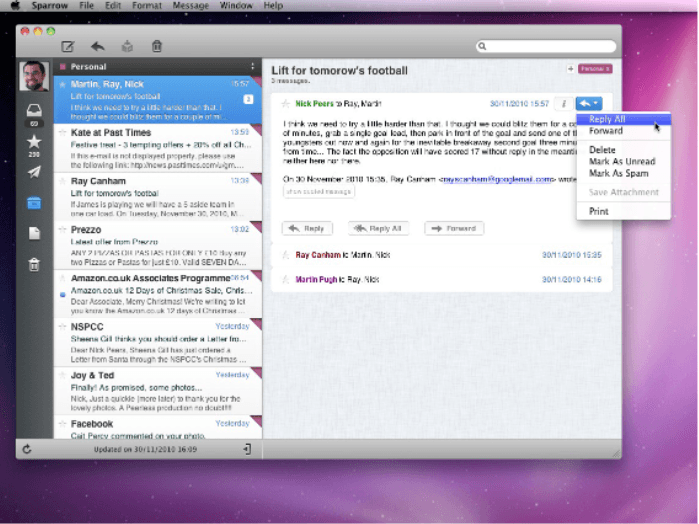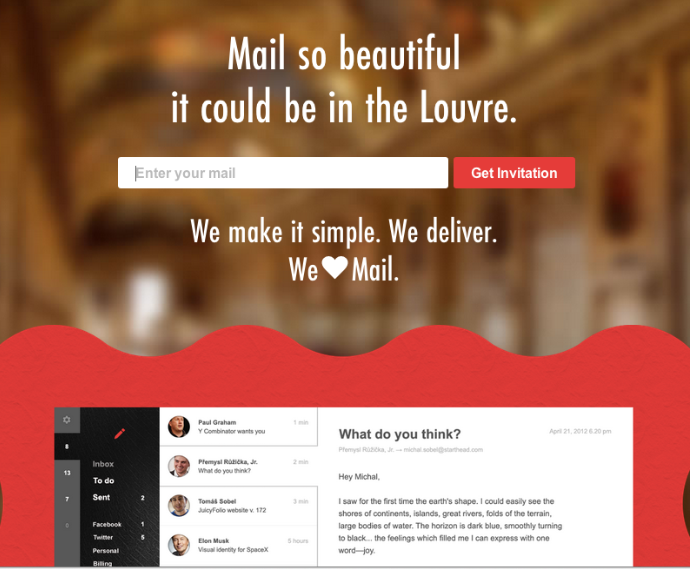This article hit home since we, at Front, are trying to innovate in this space. We are really in line with the different points raised by Des (Ok, maybe he is missing the point that making an email client more collaborative could be relevant for companies :-)).
However, if on paper all these innovations sound very promising it’s a whole different story when it comes to delivering these products. Because it’s incredibly hard to build them.
Launching an email startup can lead you to the startup graveyard faster than you think
Intercom illustrates its article with several examples of startups innovating in this space. One year later let’s see what happened to them.

Sparrow was already acquired by Google at that time.
Mailbox got acquired shortly after for a nifty $100 million by Dropbox (march 2013). Since then the email client is still iOS only (no Android version yet and no desktop version announced) and is compatible with Gmail, Yahoo mail, and iCloud (the last two were announced only a couple of months ago).

MyMail is still a designer prototype at the moment.

Mailer: still under the radar, no beta registration form.

Alto mail (from AOL) was already up and running

Welovemail was still invite-only at the time.
outline => still a Dribbble design only
mail pilot => went out of beta after 2 years and now offers both a mobile and a desktop client. They are already working on a V2
attachments.me => shut down
personamail => still in private beta
unibox => went out of beta and is now available
So if you make the count out of 9 projects that were not publicly released yet, one year after only 2 could release a V1 product: mail pilot and Unibox. The others are either still building their product or hit the deadpool.
Why is it so hard to build an email product?
The aim is not to point these startups specifically and say they did a terrible job. This is quite the opposite, we admire these startups. No, the point is to show how long the cycles are when it comes to building an email product. We are also building one and, hell, we can confirm that it’s hard.
Users’ expectation bar is extremely high
When it comes to software, in general, people can forgive a lot of things: some bugs in their Twitter client, missing features in their CRM, not well-polished interface in their invoicing tool, etc. until it doesn’t completely destroy the core experience.
The problem with email is that we are ALL email experts since we ALL spend a lot of time sending, answering, and managing them.
Here is a list of what users expect from day one in their email client:
high reliability: it has to work all the time. Downtimes are deal breakers in this space.
huge number of minimal core features: composer, attachment handling, tags, draft, archive, trash, conversation threading, contact management etc. Don’t think there’s a shortcut here.
magic onboarding: most people already have several mail clients (web, mobile or desktop-based). If they don’t perceive the value of your product and how it works within 5 minutes they’ll just go back to their current solution and forget about you. Forever.
high security/confidentiality levels: people don’t care if their emails are used by Google to push ads or if the NSA spies on them. However, they do care if a young startup is dealing with what they consider a really private part of their life.
And here is a list of what users expect from day two:
multi-platforms: from IMAP to Gmail, Yahoo mail, Hotmail. People want to be able to connect each of these email providers all to their app.
multi-devices: people check their emails everywhere and on all their devices. From computer to phone or tablet.
customization: dealing with email is a very personal experience. Some people like to be well organized and archive all their emails to keep it clean. Some others don’t care but are tags addicts. Your UX should enable them to naturally choose the experience they want.
From a technical point of view building, a mail client is no easy task
The consequence of these high expectations is that you need to have really strong Front-end and Back-end skills to build this kind of product.
Emails are still transmitted in a decade-old format, that has been patched again and again to do new things. You’ll need to master Base64, Quoted-Printable, UTF-8, MIME, Multipart etc. before attempting to display your first email. Then all the minimal core features we talked about have to work perfectly before you can start innovating.
Therefore building an MVP is long and complicated here, let alone a first stable version. And once you have this in place you need very talented people to take it to the next level. From a design (UX/UI) and a technical point of view.
Start small
Most startups have a long-term vision but all of them have to start somewhere before. In the email space, you can start with a plugin (a Gmail extension) or go directly face to face with building a complete email application. You can choose to target one platform (iOS only) or to be multi-platforms from day one. You can choose to be Google Apps compatible only or to integrate other providers.
We sincerely don’t think that there is a better approach, it’s just how you execute your plan that makes the difference in the end.
We choose to start with a full-featured desktop application targeting businesses. In our app, companies can create Shared Inboxes and collaborate on their Customer Support, Hiring, Sales, Projects, etc. Even though the challenge is really tough and even though our chances of succeeding are low we still want to take the plunge. Yes, we are crazy.
Written by Mathilde Collin











